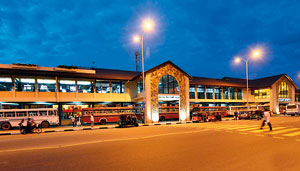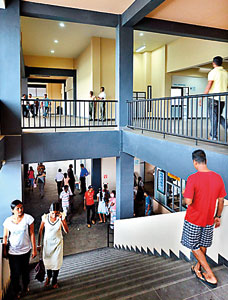The Galle Bus Stand captured the world’s attention when it was hit by the tsunami in 2005, with many lives being lost in the massive wave that destroyed it. A temporary bus stand was built incorporating the undamaged centre part of the building but it was not sufficient for the needs of the commuters.
Five years later, the new bus stand was declared open by President Mahinda Rajapaksa on July 11. The architect and project manager was D.H. Wijewardene Associates and the Central Engineering Consultancy Bureau- Southern Region headed by Eng. S.P.P. Nanayakkara and assisted by Eng. Sunil Jayawardene carried out structural designs and the construction work within just eight months.
Due to the nature of the site and its location, the new building was planned from one main road to another.
To break this monotony, three porches were constructed with the main one at the centre. Buses can drive down under these porches and spaces created at the first floor level have become usable areas. The main porch falls between the gaps of two buildings of the cricket stadium, thus creating a good view of the wicket. A large cafeteria has been planned in this place to take in the view from the first floor.
A common problem with bus stands is that there is no proper protection from the weather when the commuter is getting into the bus. In the Galle bus stand, the upper level of the slab cantilevers out around 8’0” creating adequate protection.
While 30 bus bays are located in the ground level, a series of shops by the side of the long thoroughfare runs along the building from one end to another on the first floor. A ten foot-wide staircase connects the bus stand with this walkway at the centre, and two smaller staircases located at the two corners also connect to it avoiding any dead ends.
Making this long walkway functional at the first floor level, an overhead bridge is connected to it from the railway station over the canal and also over the side road, providing safe access to rail and bus commuters. Commuters entering from the railway station side, could get down to the bus stand at three different points or go to the city descending from the furthest staircase.
Two terraces have been planned at the two ends of the building having access from the two staircases at the two ends. These could be rented out for small functions and also serve as rescue spaces in case of another tsunami.
Spacious, well equipped toilets at both levels are available and rest rooms and toilet facilities for the disabled are located on the ground floor.All route numbers, time tables and fares have been computerized and displayed at several locations in all three languages for the benefit of bus travellers.
One of the most important aspects of this landmark project, was that it should match the character of the heritage city of Galle. The design of this bus stand is in full harmony with the landscape.
The roof, walls, railings, columns and arched windows enhance the beauty of the building. Black columns and beams in the ground floor give an impression of old world grandeur.
The two bridges with large black arches are two very elegant features of this new building complex. Today in other parts of the world, bridges and walkways are designed by architects and are features of their cities to attract tourists and visitors. Perhaps this may be the same for Galle.
|



